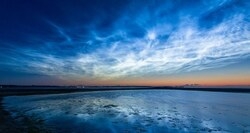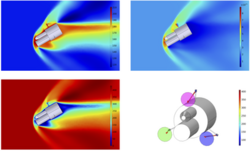Kurzfassung
Simulations of the supersonic flow around a sounding rocket payload and of the impaction-based sampling efficiency of mesospheric particles
Nachtleuchtende Wolken [1]
Seit Ende des 19. Jahrhunderts ist die Existenz des nachtleuchtender Wolken (NLC) bekannt. Diese sind Mesosphärische Wolken, die in den Sommermonaten sichtbar sind. Bisher ist nicht schlüssig geklärt, an welchen Kondensationskernen diese Wolken sich bilden und wie sich die Wolkentröpfchen zusammensetzen. Ein Grund für...
Simulations of the supersonic flow around a sounding rocket payload and of the impaction-based sampling efficiency of mesospheric particles
Nachtleuchtende Wolken [1]
Seit Ende des 19. Jahrhunderts ist die Existenz des nachtleuchtender Wolken (NLC) bekannt. Diese sind Mesosphärische Wolken, die in den Sommermonaten sichtbar sind. Bisher ist nicht schlüssig geklärt, an welchen Kondensationskernen diese Wolken sich bilden und wie sich die Wolkentröpfchen zusammensetzen. Ein Grund für diese Ungewissheit liegt in der Schwierigkeit, die Partikel in solch großen Höhen zu sammeln und sie anschließend einer physikalisch-chemischen Analyse zu unterziehen. Sondierungen und analytische Untersuchungen in solchen Höhen sind nur mit großem Aufwand durch Höhenforschungsraketen möglich.
Numerische Simulationen unterstützen die Entwicklung eines Messgeräts für Partikelimpaktionen und erlauben Vorhersagen über die Kollisionsprozesse und die Effizienz der Teilchenentnahme.
The goal is to develop an impaction-based probe collector that allows particle impactions in the supersonic free stream radially aside the rocket body (for details on the rocket see [2]). Numerical simulations using the PDE software COMSOL Multiphysics support the development of the sampling mechanism’s design. Of particular interest is the evaluation of the evolving flow field around the payload of a sounding rocket at high Mach numbers (with Ma1 = 1.31 and Ma2 = 1.75 at 85 km) including the essential flow variables (e.g., velocity, pressure). Furthermore, the thickness of the boundary layer is investigated to prevent it from influencing the impaction processes as an artifact. Further questions are aimed at the design or arrangement of the impactor arms. Finally, particle trajectories are calculated based on the environmental conditions, which lead to the confirmation of possible impaction processes.
To simulate the high Mach number flow around the sounding rocket payload under ambient conditions, the Navier-Stokes equations for compressible fluids are used. To solve the underlying PDEs, the finite element method is used with the application of linear shape functions for the fluid velocity, pressure, and temperature. For modeling the particle trajectories, the ordinary differential equations from Newton’s second law are applied with corresponding particle forces.
Evaluation of flow field variables of temperature, density, and velocity for the flow velocity of 400 m/s for the flight attitude of -30◦. Furthermore, trajectories of impacting particles are depicted.
The simulations consider three different flight attitudes (i.e. angles of attack) of the sounding rocket during flight: 0◦ and ±30◦ (angle between the inflow direction and the longitudinal axis of the rocket). The simulations are conducted for flight velocities of 300 m/s and 400 m/s. The resulting flow fields show corresponding shock waves generated at both the payload tip and the protrusions. Figure 1 depicts evaluated flow field variables at the inflow velocity of 400 m/s of the final scientific payload geometry with measuring surfaces. Temperature, air density, and velocity for an angle of attack of -30◦ are shown on a cut plane. Visible is the asymmetric shock wave region arising at this position, where steep gradients occur. Furthermore, the thickness of the boundary layers in each of the calculated rocket positions are evaluated. Based on this, the distance of the impactor arms from the payload hull is determined in order to sample particles in the free flow. The cloud ice particles of NLCs presumably exist under comparatively unstable conditions at mesospheric altitudes. Temperature fluctuations, as they occur in the flow field around the rocket body, likely cause the ice to sublimate. Therefore, particle trajectories are calculated for very small ice nuclei (with a diameter of 1.2 nm), which are released after complete sublimation of the former ice particle. Since the concentration of NLC cloud particles is estimated to be about 10 1/cm^3 [3], simulations are performed with a variety of particle concentrations (1 to 38 1/cm^3). The results of the particle simulations show impaction processes (see Figure 1) onto the impactor surfaces, which provides strong indications that the impact mechanism will also proceed in reality.
The numerical simulations with COMSOL allow the analysis of the flow field around the payload of a sounding rocket, including the corresponding flow variables and the evolving boundary layer. With support of these analyzes, a measuring device for particle collection is designed and particle impacts onto designated collection surfaces are highly probable according to the calculated trajectories of the particles.
REFERENCES
[1] M. Süßen. Sikimedia commons. https://commons.wikimedia.org/w/index.php?search=noctilucent&title= Special:MediaSearch&go=Go&type=image, 2019. Accessed: 2021-06-02.
[2] K. Naumann, C. Kirchberger, O. Drescher, D. Hargarten, M. Zurkaulen, A. Haubl, S. Rest, H. Niedermaier, J. Ramsel. Design of a hovering sounding rocket stage for measurements in the high atmosphere, 2020.
[3] R. P. Turco, O. B. Toon, R. C. Whitten, R. G. Keesee, D. Hollenbach. Noctilucent clouds: Simulation studies of their genesis, properties and global influences, Planetary and Space Science, 1982.
» weiterlesen» einklappen


